#christie 1972
Quote
I had never felt more helpless. The power that defeated us was still at large, undefeated, and though quiescent for the minute we could hardly regard as doing otherwise than biding its time.
Agatha Christie, The Witness for the Prosecution and Other Stories
#trump 2024#us presidental election#class struggle#agatha christie#christie#the strange case of sir andrew carmichael#1972#christie 1972#quote#the witness for the prosecution and other stories
0 notes
Text

Pendant given to Pattie Boyd by Eric Clapton
Mick Milligan
Early 1970s
Christie's: The Pattie Boyd Collection (Lot 40)
#pendant#jewelry#pattie boyd#1970s#1970#1971#1972#1973#enamel#ruby#sapphire#british#united kingdom#christie's
1K notes
·
View notes
Text



Andy Warhol and his boyfriend Jed Johnson at a preview for the inaugural exhibition "Johns, Stella, Warhol: Works in a Series" at the Art Museum of South Texas in Corpus Christi on October 4, 1972.
95 notes
·
View notes
Text

Robert Motherwell, "The Red Wall," 1972,
Acrylic and Charcoal on Canvas,
72 x 72 in (182.9 x 182.9 cm).
Christie's in New York
#art#abstract#abstraction#painting#abstractart#minimal#christie's#robert motherwell#red#wall#1972#charcoal
101 notes
·
View notes
Text
prior to today i had not experienced, in any way, one of agatha christie's stories so it was "hm yes i have heard she has fucked up little guys" and after today it's
"oh
she LOVES
her FUCKED UP LITTLE GUYS"
3 notes
·
View notes
Text
"Avenues and alleyways" - Tony Christie
1972
Written by Mitch Murray and Peter Callander
What lurks down yonder path? Let's Do It, my personal fifty favourite singles from 1954-76.
The theme to telly series The Protectors, "Avenues and alleyways" begins with an ominous little five-note sequence, full of suspense and danger and mystery. Who lurks down this shadowy passage, who is the cloaked figure silhouetted by a street lamp?
Tony Christie is a Yorkshire lad, brought up on Glenn Miller and Frank Sinatra, and Tony has always been at his best when using his booming chest voice. By the early 1970s he was being managed by Harvey Lisberg (also: Herman's Hermits, Godley and Creme, Sad Café, and snooker star Jimmy White), with all the connections of Manchester's best manager. Lisberg connected Christie with the Murray-Callander songwriting partnership who wrote Christie's biggest hit "I did what I did for Maria".

Why do I prefer this to "…Maria" or Tony's other big hit "Is this the way to Amarillo?". It's the atmosphere. It's the backing music, crafted to evoke a mood. Even for those of us who have never seen The Protectors, we can get enough from this theme song to know roughly what lies in store. Danger, darkness, subterfuge. Wouldn't want to bump into the narrator down a dark alley, but what a thrilling way to go…
More: Tony in conversation with Adrian Goldberg
youtube
#tony christie#avenues and alleyways#1972#the protectors#gerry anderson#tv theme#let5d0it#let's do it#pop music#20th century#1954-1976
0 notes
Video
youtube
UK Chart Hits - 1972
Christie - Iron Horse
(1 weeks in chart peaking at No. 47)
0 notes
Text

JOSEPH CORNELL (1903-1972)
L'Humeur Vagabonde #1
signed, titled and dated 'L'Humeur Vagabonde Joseph Cornell 1955' (on the reverse)
wood box construction—paint, glass, wood, mirror, driftwood, porcelain, ribbon, printed paper, rubber ball and tin
Christie’s
1K notes
·
View notes
Photo



Get a glimpse of Marilyn Monroe's stunning costume from the 1956 film 𝑩𝒖𝒔 𝑺𝒕𝒐𝒑, designed by the talented Travilla. This jade green satin leotard features a black netting overlay, jet-like sequins, and scalloped gold bullion fringe with topaz-colored faceted glass.
The costume, worn by Monroe as Cherie, was later used by Leslie Caron in the 1959 film 𝑻𝒉𝒆 𝑴𝒂𝒏 𝑾𝒉𝒐 𝑼𝒏𝒅𝒆𝒓𝒔𝒕𝒐𝒐𝒅 𝑾𝒐𝒎𝒆𝒏. It even made an appearance in 1972 when worn by Christie's employee Jane Kerin for a promotional photo.
The piece eventually went up for auction in 2016, selling for $100,000! There is a Hollywood story claiming the piece Monroe wore was actually reused from an earlier production, as she wanted something that looked old. In any case, it's possible that multiple copies of this costume are floating around, and though the ones worn by Monroe and Caron may not be the same exact piece, they certainly derive from the same set.
Discover more incredible costumes like this one by visiting our website. Bit.ly/PostEd070
#MarilynMonroe#BusStop#LeslieCaron#TheManWhoUnderstoodWomen#Travilla#Costumes#CostumeDesign#CostumeIdeas#CostumeHistory
233 notes
·
View notes
Text

Agatha Christie Books in Order.
Hercule Poirot Books
Hercule Poirot Collections
Miss Marple Books
Miss Marple Collections
Tommy and Tuppence Books
Tommy and Tuppence Collections
Superintendent Battle Books
Standalone Novels
Short Story Collections
Non-Fiction Books
Agatha Christie Hercule Poirot books in order
Here are the names of Agatha Christie’s Hercule Poirot books in order. It will help you start with your reading while ensuring the best experience.
The Mysterious Affair at Styles (1920)
The Murder on the Links (1923)
The Murder of Roger Ackroyd (1926)
The Big Four (1927)
The Mystery of the Blue Train (1928)
Peril at End House (1932)
Lord Edgware Dies (1933)
Murder on the Orient Express (1934)
Three Act Tragedy (1935)
Death in the Clouds (1935)
The A.B.C. Murders (1936)
Murder in Mesopotamia (1936)
Cards on the Table (1936)
Dumb Witness (1937)
Death on the Nile (1937)
Appointment with Death (1938)
Hercule Poirot’s Christmas (1938)
One, Two, Buckle My Shoe (1940)
Sad Cypress (1940)
Evil Under the Sun (1941)
Five Little Pigs (1942)
The Hollow (1946)
Taken at the Flood (1948)
Mrs. McGinty’s Dead (1952)
After the Funeral (1953)
Hickory Dickory Dock (1955)
Dead Man’s Folly (1956)
Cat Among the Pigeons (1959)
The Clocks (1963)
Third Girl (1966)
Hallowe’en Party (1969)
Elephants Can Remember (1972)
Curtain (1975)
The Monogram Murders (2014)
Agatha Christie Hercule Poirot Collections in Order
Poirot Investigates (1924)
Murder in the Mews (1937)
The Labours of Hercules (1947)
Poirot’s Early Cases (1974)
Agatha Christie Miss Marple Books in Order
Here is the list of Agatha Christie’s books in order based on their publication date.
The Murder at the Vicarage (1930)
The Body in the Library (1942)
The Moving Finger (1942)
A Murder is Announced (1950)
They Do It with Mirrors (1952)
A Pocket Full of Rye (1953)
4:50 From Paddington (1957)
The Mirror Crack’d (1962)
A Caribbean Mystery (1964)
At Bertram’s Hotel (1965)
Nemesis (1971)
Sleeping Murder (1976)
Agatha Christie Miss Marple Collection in Order
The Thirteen Problems (1932)
Miss Marple’s Final Cases (1979)
Agatha Christie’s Tommy and Tuppence Books in Order
Here’s the list of Agatha Christie Tommy and Tuppence Books in Order
The Secret Adversary (1922)
N or M? (1941)
By the Pricking of My Thumbs (1968)
Postern of Fate (1973)
Agatha Christie’s Tommy and Tuppence Collections in Order
Partners in Crime (1929)
Agatha Christie’s Superintendent Battle Books in Order
Here’s the list of Agatha Christie Superintendent Battle Books in Order
The Secret of Chimneys (1925)
The Seven Dials Mystery (1929)
Cards on the Table (1936)
Murder is Easy (1939)
Towards Zero (1944)
Agatha Christie’s Standalone Novels in Order
Here’s the list of Agatha Christie Standalone Novels in Order
The Man in the Brown Suit (1924)
Giant’s Bread (1930)
The Sittaford Mystery (1931)
Unfinished Portrait (1934)
Why Didn’t They Ask Evans? (1934)
And Then There Were None (1939)
Absent in the Spring (1944)
Death Comes as the End (1944)
Sparkling Cyanide (1945)
The Rose and the Yew Tree (1948)
Crooked House (1949)
They Came to Baghdad (1951)
A Daughter’s a Daughter (1952)
Destination Unknown (1954)
The Burden (1956)
Ordeal by Innocence (1958)
The Pale Horse (1961)
Endless Night (1967)
13 at Dinner (1969)
Passenger to Frankfurt (1970)
The Murder at Hazelmoor (1984)
Agatha Christie’s Short Story Collections in Order
Here’s the list of Agatha Christie Short Story Collections in Order
The Mysterious Mr. Quin (1930)
The Hound of Death (1933)
The Listerdale Mystery (1934)
Parker Pyne Investigates (1934)
The Regetta Mystery and Other Stories (1939)
The Witness for the Prosecution and Other Stories (1948)
Three Blind Mice and Other Stories (1950)
The Under Dog and Other Stories (1951)
The Adventure of the Christmas Pudding (1960)
Double Sin and Other Stories (1961)
Star Over Bethlehem and Other Stories (1965)
The Golden Ball and Other Stories (1974)
The problem at Pollensa Bay and Other Stories (1991)
The Harlequin Tea Set (1997)
While the Light Lasts and Other Stories (1997)
Agatha Christie’s Non-Fiction Books in Order
Here’s the list of Agatha Christie Non-Fiction Books in Order
Come, Tell Me How You Live (1946)
Agatha Christie: An Autobiography (1977)
Top 10 Agatha Christie Books to Read
Given the number of books in the Agatha Christie series, readers generally hesitate to begin. Further, to understand the series well, one needs to read Agatha Christie’s novels in order. To ease things, the readers generally look for the best novels or books to read them directly and avoid all the hassle. So here are the top 10 Agatha Christie novels that will offer you the best mystery story reading experience.
#agatha christie#poirot#hercule poirot#miss marple#tommy and tuppence#superintendent battle#literature#english literature#books#classics#crime novles#1920s#1930s#1940s#1950s#1960s#1970s#vintage
105 notes
·
View notes
Text
René Lalique was born #OTD (6 April 1860 - 1 May 1945). Since it's also still #BatAppreciationWeek, here are a few of Lalique's many bats!
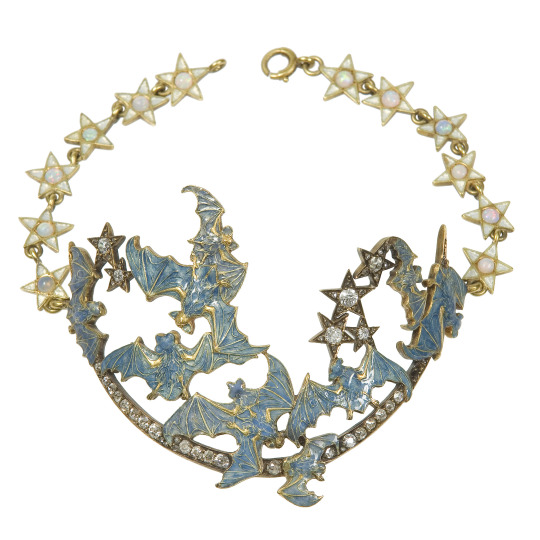
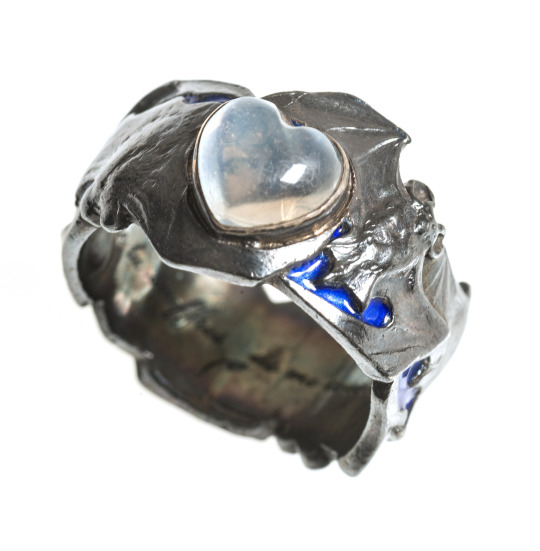
1. bat anklet c.1898-9; gold, enamel, antique & rose diamond, opal
2. bat ring c.1899; silver, enamel, moonstone, gold
both Musée des Arts décoratifs
Both these pieces were commissioned as gifts for American writer Natalie Clifford Barney (1876-1972), who was openly lesbian; bats were a Fin de siècle symbol of homosexuality. But they were also popular Art Nouveau motifs thanks to Japonisme. Here is another example:

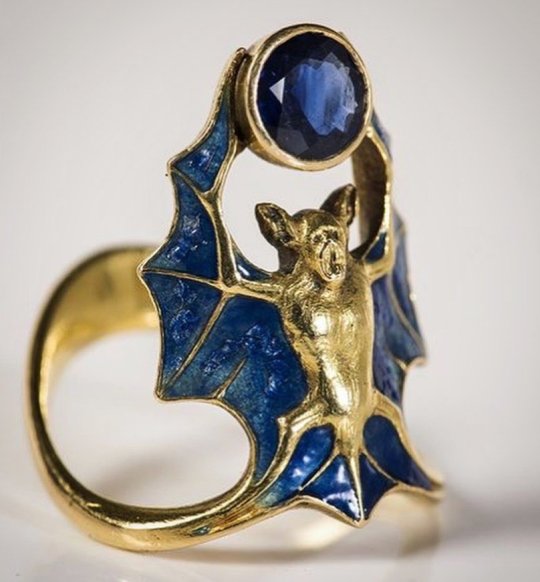
3. Ring c.1901, gold, blue enamel, sapphire
And another, this one paired with another popular Art Nouveau animal:
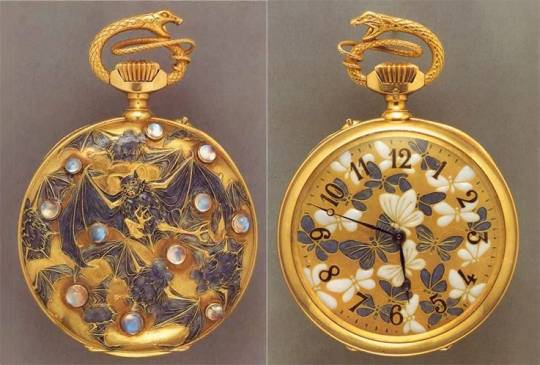
4. "Butterflies and Bats" pocketwatch, c. 1899-1900; gold, enamel, moonstone.Via Christie's (sold in 2002 for US$207,500)
#René Lalique#Lalique#jewelry#jewellry#ring#anklet#watch#pocketwatch#decorative arts#Art Nouveau#19th century art#20th century art#1890s#1900s#Fin de siècle#Japonisme#Musée des Arts décoratifs#Christie's#metalwork#gold#silver#gemstones#bat#bats#butterfly#butterflies#insects
561 notes
·
View notes
Text

Maurits Cornelis Escher (1898-1972) - Sun and Moon
Woodcut in black, grey, orange and yellow on thin laid Japan paper. Printed in 1948.
Sheet: 13.3 x 13.8 inches, 33.8 x 35 cm. Estimate: £24,000-35,000.
To be sold Christie's, London, ending 26 Sept 2024.
22 notes
·
View notes
Text
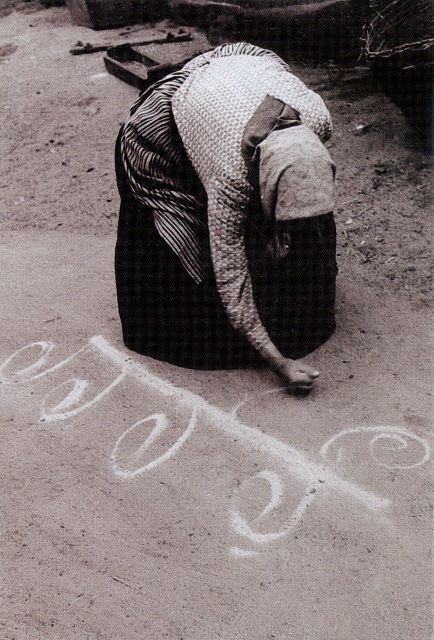

"Drawing protective or decorative symbols with sand is an old custom from the rural parts of Poland, first described by ethnographers in 19th century. In Polish it’s usually called ‘sypanie piaskiem’ (what translates simply to ‘pouring of sand’). It used to be common to many regions located in the modern-day central Poland. This tradition started disappearing first due to changes of construction materials inside cottages and their surroudings (explained below). Later it died out almost completely during the secular communist rule and the rapid industrialization of the Polish countryside after World War 2.
The co-called ‘sand carpets’ were prepared for religious feasts, most notably for Easter but also for other religious spring feasts, of which many bear traces to pre-Christian Slavic beliefs (read for example: the Green Week or the Polish celebrations of Corpus Christi)."
quoted from a blog post by Lamus Dworski
the first photo is cited as: Archival photo, region of Kujawy in Poland. From magazine “Gadki z chatki”.
the second as: Archival photo taken in Kujawy, 1972, from the collections of Museum of Kujawy and Dobrzyń Lands.
200 notes
·
View notes
Text
On March 9, 1977, Francine Hughes returned from business college to her Dansville, Michigan, home and put a frozen dinner in the oven for her husband, James. He didn't like it. Francine, he said, should be at home preparing meals for him, not running off to school. He beat her up, as he had done many times before; and to drive home his point he tore up her schoolbooks and term papers and forced her to burn them in the trash barrel. Twelve-year-old Christy Hughes called the police, who came to the house long enough to calm James down but declined, as they had many times before, to arrest him. They left James, tired from beating Francine, asleep in his bedroom. Determined to "just drive away," Francine piled the children into the family car. "Let's not come back this time, Mommy," they said. She carried a gasoline can to the bedroom, poured the contents around the bed where James lay asleep, backed out of the room, and set a match to it The rust of flame sucked the door shut.
Francine Hughes drove immediately to the Ingham County sheriffs office, crying hysterically, "I did it. I did it." She was charged with first-degree murder.
Dansville adjoins East Lansing, home of Michigan State University and consequently of many social-action groups. Within two months feminists and other interested people in the Lansing area had formed the Francine Hughes Defense Committee to raise money and public awareness for her defense. They were careful to say that they neither advocated nor condoned murder, but they held that women confronted with violence have a right to defend themselves. They argued that "Francine Hughes—and many other women facing similar charges—should be free from the threat of punishment," for Francine Hughes was a battered woman.
At the time wife-beating was a growing feminist issue, following close on the heels of feminist attacks upon rape, a crime it resembles in many ways. Both rape and wife-beating are crimes of violence against women. Both are widespread, underreported, trivialized, and inadequately punished by the legal system. Both are acts of terrorism intended to keep all women in their place through intimidation. In fact, rape is often part of wife abuse, though so far only a few states acknowledge even the possibility of rape within marriage. The chief difference between the two crimes is that while the victim of nonmarital rape must live with a terrifying memory, the abused wife lives with her assailant. Rapists are, in Susan Brownmiller's phrase, the "shock troops" of male supremacy. Wife-beaters are the home guard.
American feminists took up the issue of wife-beating when they learned in 1971 of the work of Erin Pizzey, founder of Chiswick Women's Aid, the first shelter house in England exclusively for battered women and their children. Rainbow Retreat, the first American shelter for abused families of alcoholics opened in Phoenix, Arizona, on November 1, 1973; and in St. Paul, Minnesota, Women's Advocates, a collective that began with a phone service in 1972, opened Women's House to battered women and their children in October 1974. Rainbow Retreat, during its first two and a half years, sheltered more than six hundred women and children. In St. Paul the five-bedroom Women's House sheltered twenty-two women and fifteen children during its first month of operation; less than a year later Women's Advocates were negotiating to buy a second house. Across the country the shelter movement spread to Pasadena, San Francisco, Seattle, Boise, Albuquerque, Pittsburgh, Ann Arbor, Boston, New York. To open a shelter was to fill it beyond capacity almost overnight. Suddenly it seemed that battered women were everywhere.
While activists opened shelters, researchers and writers set about documenting the problem of wife-beating or, as it came to be called more euphemistically in the academic literature, "domestic violence." The records showed that 60 percent of night calls in Atlanta concerned domestic disputes. In Fairfax County, Virginia, one of the nation's wealthiest counties, police received 4,073 disturbance calls in 1974. During ten months in 1975-76 the Dade County Florida Citizens Dispute Settlement Center handled nearly 1,000 wife-beating cases. Seventy percent of all assault cases received in the emergency room at hospitals in Boston and Omaha were women who had been attacked in their homes. Eighty percent of divorce cases in Wayne County, Michigan, involved charges of abuse. Ninety-nine percent of female Legal Aid clients in Milwaukee were abused by men.
The FBI guessed that a million women each year—women of every race and social class—would be victims of wife-beating. Journalists Roger Langley and Richard C. Levy put the figure at more than 28 million. Some said that one in four women married to or cohabiting with a man would become a victim; others said one in three. In some areas the incidence seemed even greater. In California the experts said one of every two women would be beaten. And in Omaha, the Mayor's Commission on the Status of Women estimated that 95 percent of women would be abused at some time. There scarcely seemed need of additional evidence, so the same statistics began to turn up in every new account, but repetitious as they were, they showed all too clearly that wife-beating is a social problem of astounding dimensions.
-Ann Jones, Women Who Kill
218 notes
·
View notes
Text
Knives Out Reference Guide
hello it’s your friendly neighborhood obsessive murder mystery fan here. the knives out films are delightful for a number of reasons, one of which is that rian johnson is a huuuuuge movie nerd and loves to include references and hat tips in his films. i have had great fun recognizing those references, so here is a little guide! some of this is based on things johnson has said and some of it on my own observations. i’ll indicate which is which for the purists.

first off, if you’re not interested in having these pointed out to you but want a viewing list, here it is! i’ll put everything else under a cut (which will have glass onion spoilers, so beware). these are great movies for knives out reasons but also for normal film reasons, and i highly recommend them.
Sleuth (1972)
Death on the Nile (1978)
The Last of Sheila (1973)
Evil Under the Sun (1982)
First off: Benoit Blanc himself.
Blanc is very clearly meant to be an homage to gentlemen sleuths of the past, and Johnson even gives us a clue as to which gentleman sleuth he was thinking of with Blanc, with his Southern gentleman amidst the Northerners aping Hercule Poirot’s Belgian-amongst-the-Brits. Johnson has also said that Peter Ustinov is his favourite portrayer of Poirot (fun fact: he was also Agatha Christie’s!--not that she lived to see David Suchet take on the role), and personally I think having Blanc direct the questioning from the piano in Knives Out was an echo of Poirot at the piano in a similar scene in Death on the Nile.
That said, I think there’s a lot of Miss Marple (and Jessica Fletcher, who is herself a modern Miss Marple) in Blanc. The way he has a tendency to observe while deputizing a younger assistant to do the actual snooping for him is very Jane Marple. And he weaponizes the lil-ol’-me Southern gentleman act in much the way Marple made use of the assumptions people in her day and age had about retiring spinsters.

now let’s get into the FILMS. the first one is easy, because it’s really just Sleuth. (1972. i cannot stress this enough--Sleuth 1972.) it does not share a plot, but Knives Out is clearly paying a lot of tribute. Sleuth is a film in which two men, one older and richer and laurence olivier and the other younger and poorer and michael caine, attempt to outwit one another in order to win the woman they both love but who we never see (and yes it’s very very homoerotic). (fun fact: Sleuth was originally a play by Anthony Schaffer--who also wrote the screenplay for Death on the Nile!--who based the elder character in part on Stephen Sondheim, who loved to play games.) it’s set entirely inside the rambling manor house belonging to olivier’s character, a mystery writer, and it’s full of figurines and automatons, and otherwise weird old shit. you seeing how this lines up?
there’s even a very direct tribute in the form of the sailor you see almost immediately in the film.
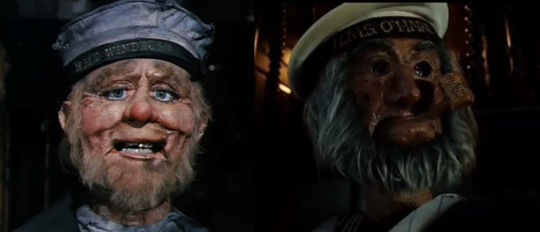
however, aside from the setting and the blueprint for harlan’s character, there aren’t a lot of similarities between Knives Out and Sleuth. Knives Out is much more a play on general mystery tropes than it is a specific mystery movie.
Glass Onion is very much the opposite.
(FROM THIS POINT ON, GLASS ONION SPOILERS ABOUND)

Glass Onion is playing very deliberately on The Last of Sheila. The Last of Sheila (written by Anthony Perkins and Stephen Sondheim name a more iconic duo i’ll wait) is about a wealthy and powerful man who invites a group of old friends onto his yacht (”Sheila”) in order to play a series of games (i see u Stephen) and perhaps solve a mystery? (the mystery is who killed his wife, Sheila.) The friends all come in spite of misgivings because they all need something from their host.

Glass Onion is about a wealthy and powerful man who invites a group of old friends onto his private island in order to play a game and solve a mystery (the mystery is who “killed” him). the friends all come in spite of misgivings because they all need something from their host.
so you see what’s he’s done there.
it’s a very loving tribute, and johnson has put his own distinctive spin on it, both with the addition of a detective who nobody expected to be there, as well as the inexperienced assistant whom he’s deputized. but unlike your typical watson and very like marta’s character in Knives Out, helen in Glass Onion has a huge personal stake in solving the mystery. also, of course, Miles is a very specific, recognizable piece of shit.
but door, you might be saying, because you have very closely read this post for some reason, what about Evil Under the Sun? oh, i am so glad you asked!

Evil Under the Sun is another Ustinov Poirot mystery, set in a resort on a private island. The trappings of Glass Onion owe much to it, from the luxury getaway setting (complete with swim fits), to the opportunity to have your characters dress for cocktails, to the “hourly dong” (based on Evil’s “hourly gun”). oh, and i know this was deliberate:

so! that’s what i’ve got! if you noticed other things i missed (i’ve only seen Glass Onion once at this point), please let me know!
#here it is ashleigh!#enjoy!#knives out#glass onion#glass onion spoilers#murder mysteries#rian johnson be my penpal challenge
396 notes
·
View notes
Text

youtube
youtube
Luchi DeJesus was one of the go-to composers for Blaxploitation music. He did the background music for Slaughter (1972), Detroit 9000 (1973), Black Belt Jones (1974), Get Christie Love (1974), and Friday Foster (1975).
12 notes
·
View notes